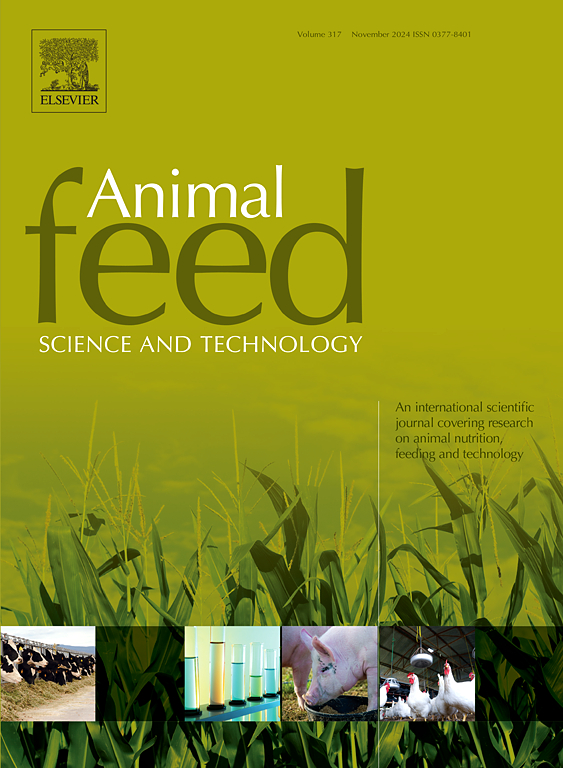Effect of pick-up height during merging and microbial inoculation on the fermentation profile of alfalfa silage at different storage lengths
IF 2.5
2区 农林科学
Q1 AGRICULTURE, DAIRY & ANIMAL SCIENCE
引用次数: 0
Abstract
This experiment evaluated the effects of pick-up height during merging and microbial inoculation on fermentation profile of alfalfa silage at different storage lengths. This experiment was a randomized complete block design with a 2 (pick-up height during merging) × 3 (microbial inoculation) × 4 (storage length) factorial arrangement of treatments. Forage from four different blocks (locations) was merged into windrows at a pick-up height of 0 cm (LO) or 6 cm (HI). Then, forage was inoculated with one of two microbial inoculants or control: (1) 150,000 CFU/g of fresh forage of Lactiplantibacillus plantarum DSM26571, Lactococcus lactis NCIMB30117, and Enterococcus lactis DSM22502 (LPEL; SiloSolve® MC, Novonesis, Lingby, Denmark), (2) 150,000 CFU/g of fresh forage of Lactococcus lactis DSM22501 and Lentilactobacillus buchneri DSM11037 (LB; SiloSolve® FC, Novonesis, Lingby, Denmark), or (3) distilled water (CON). Forage was randomly assigned to 7, 14, 28, or 90 d of storage. Data were analyzed using fixed effects of pick-up height during merging, microbial inoculation, and storage length, while block was a random effect. Three-way interactions were observed for pH, lactic acid, and acetic acid. Alfalfa silage pH was lower for LPEL but was greater for HI silage. Lactic acid concentration was greater in LO silage and LPEL treatments, while acetic acid concentration was lower in LPEL and also greater for LO treatments. An interaction between microbial inoculation and storage length was observed for DM losses, which were lower for LPEL by 90 d of storage. Using a homofermentative microbial inoculant improved alfalfa silage fermentation and reduced storage losses, while pick-up height had little effect on fermentation.
合并过程中取货高度和微生物接种对苜蓿青贮不同贮存长度发酵曲线的影响
本试验研究了合并过程中取货高度和微生物接种对苜蓿青贮不同贮藏长度发酵特性的影响。本试验采用2(合并时取物高度)× 3(微生物接种)× 4(储存长度)的随机完全区组设计。采集高度分别为0 cm (LO)和6 cm (HI)的4个不同区(位置)的牧草合并为窗口。然后,在饲料中接种两种微生物接种剂或对照中的一种:(1)150000 CFU/g的新鲜饲料中分别接种植物乳杆菌DSM26571、乳酸乳球菌NCIMB30117和乳酸肠球菌DSM22502 (LPEL);SiloSolve®MC, Novonesis, Lingby, Denmark); (2) 150000 CFU/g乳酸乳球菌DSM22501和布氏慢乳杆菌DSM11037 (LB;SiloSolve®FC, Novonesis, Lingby, Denmark),或(3)蒸馏水(CON)。饲料随机分配至7、14、28和90 d。数据分析采用合并时取物高度、微生物接种和储存长度的固定效应,而阻塞是随机效应。在pH、乳酸和乙酸之间观察到三种相互作用。LPEL青贮pH值较低,HI青贮pH值较高。乳酸浓度在LO青贮和LPEL处理中较高,而乙酸浓度在LPEL处理中较低,LO处理中较高。微生物接种量与贮藏时间之间存在交互作用,LPEL在贮藏90 d时DM损失较低。同质发酵微生物接种剂改善了苜蓿青贮发酵,降低了贮藏损失,而收料高度对发酵影响不大。
本文章由计算机程序翻译,如有差异,请以英文原文为准。
求助全文
约1分钟内获得全文
求助全文
来源期刊

Animal Feed Science and Technology
农林科学-奶制品与动物科学
CiteScore
6.00
自引率
6.20%
发文量
266
审稿时长
3 months
期刊介绍:
Animal Feed Science and Technology is a unique journal publishing scientific papers of international interest focusing on animal feeds and their feeding.
Papers describing research on feed for ruminants and non-ruminants, including poultry, horses, companion animals and aquatic animals, are welcome.
The journal covers the following areas:
Nutritive value of feeds (e.g., assessment, improvement)
Methods of conserving and processing feeds that affect their nutritional value
Agronomic and climatic factors influencing the nutritive value of feeds
Utilization of feeds and the improvement of such
Metabolic, production, reproduction and health responses, as well as potential environmental impacts, of diet inputs and feed technologies (e.g., feeds, feed additives, feed components, mycotoxins)
Mathematical models relating directly to animal-feed interactions
Analytical and experimental methods for feed evaluation
Environmental impacts of feed technologies in animal production.
 求助内容:
求助内容: 应助结果提醒方式:
应助结果提醒方式:


